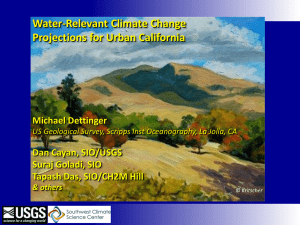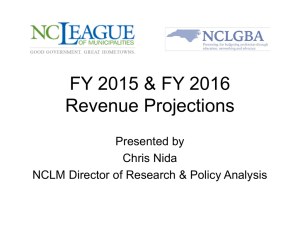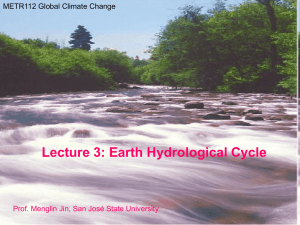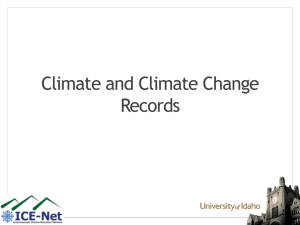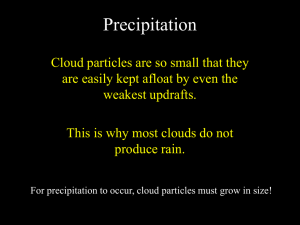ClimateChange5
advertisement
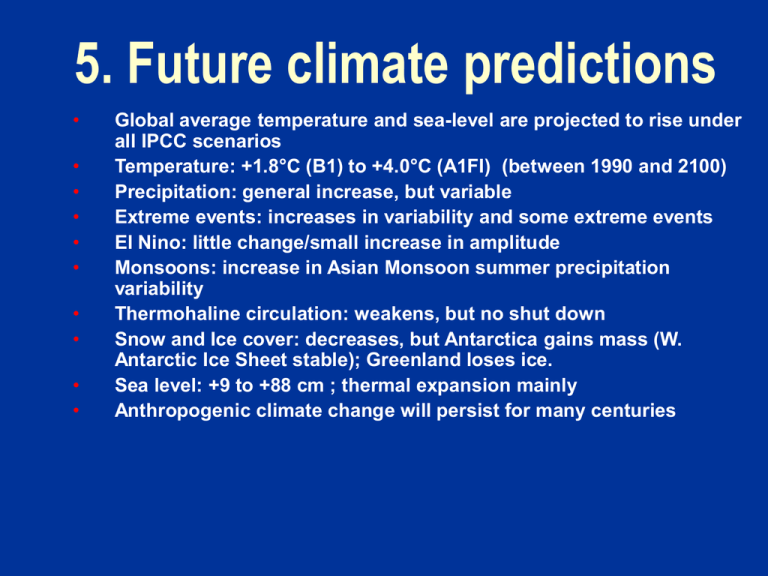
5. Future climate predictions • • • • • • • • • • Global average temperature and sea-level are projected to rise under all IPCC scenarios Temperature: +1.8°C (B1) to +4.0°C (A1FI) (between 1990 and 2100) Precipitation: general increase, but variable Extreme events: increases in variability and some extreme events El Nino: little change/small increase in amplitude Monsoons: increase in Asian Monsoon summer precipitation variability Thermohaline circulation: weakens, but no shut down Snow and Ice cover: decreases, but Antarctica gains mass (W. Antarctic Ice Sheet stable); Greenland loses ice. Sea level: +9 to +88 cm ; thermal expansion mainly Anthropogenic climate change will persist for many centuries Emissions scenarios Future concentrations of CO2 and CH4 Pre-industrial level 280 ppm Pre-industrial level 700 ppb CO2 concentrations 1000-2100 Typical glacial to interglacial range Surface temperature predictions …since 1750 Projections of Future Changes in Climate Best estimate for low scenario (B1) is 1.8°C (likely range is 1.1°C to 2.9°C), and for high scenario (A1FI) is 4.0°C (likely range is 2.4°C to 6.4°C). Broadly consistent with span quoted for SRES in TAR, but not directly comparable Projections of Future Changes in Climate Near term projections insensitive to choice of scenario Longer term projections depend on scenario and climate model sensitivities Projections of Future Changes in Climate Projected warming in 21st century expected to be greatest over land and at most high northern latitudes and least over the Southern Ocean and parts of the North Atlantic Ocean Projections of Future Changes in Climate Precipitation increases very likely in high latitudes Decreases likely in most subtropical land regions Projections of Future Changes in Climate There is now higher confidence in projected patterns of warming and other regional-scale features, including changes in wind patterns, precipitation, and some aspects of extremes and of ice. PROJECTIONS OF FUTURE CHANGES IN CLIMATE • Snow cover is projected to contract • Widespread increases in thaw depth most permafrost regions • Sea ice is projected to shrink in both the Arctic and Antarctic • In some projections, Arctic late-summer sea ice disappears almost entirely by the latter part of the 21st century PROJECTIONS OF FUTURE CHANGES IN CLIMATE • Very likely that hot extremes, heat waves, and heavy precipitation events will continue to become more frequent • Likely that future tropical cyclones will become more intense, with larger peak wind speeds and more heavy precipitation • less confidence in decrease of total number • Extra-tropical storm tracks projected to move poleward with consequent changes in wind, precipitation, and temperature patterns PROJECTIONS OF FUTURE CHANGES IN CLIMATE • Based on current model simulations, it is very likely that the meridional overturning circulation (MOC) of the Atlantic Ocean will slow down during the 21st century. • longer term changes not assessed with confidence • Temperatures in the Atlantic region are projected to increase despite such changes due to the much larger warming associated with projected increases of greenhouse gases. PROJECTIONS OF FUTURE CHANGES IN CLIMATE • Anthropogenic warming and sea level rise would continue for centuries due to the timescales associated with climate processes and feedbacks, even if greenhouse gas concentrations were to be stabilized. • Temperatures in excess of 1.9 to 4.6°C warmer than preindustrial sustained for millennia…eventual melt of the Greenland ice sheet. Would raise sea level by 7 m. Comparable to 125,000 years ago. Temperature 1000-2100 Q: Why worry about climate change ? Q: Why worry about climate change ? Q: Why worry about climate change ? Q: Why worry about climate change ? Temperature change to 2080s A1FI B2 Pathways to stabilize CO2 Impact on global economy Precipitation changes to 2080 Regional precipitation changes Change in Arctic summer sea-ice Almost no ice at N.Pole at end of the summer by the 2080s Sea-level rise Long-term changes beyond 2100 Total carbon reserves etc. Totals used under these scenarios by 2100 5. Future climate predictions • • • • • • • • • • Global average temperature and sea-level are projected to rise under all IPCC scenarios Temperature: +1.4 to +5.8 °C (between 1990 and 2100) Precipitation: general increase, but variable Extreme events: increases in variability and some extreme events El Nino: little change/small increase in amplitude Monsoons: increase in Asian Monsoon summer precipitation variability Thermohaline circulation: weakens, but no shut down Snow and Ice cover: decreases, but Antarctica gains mass (W. Antarctic Ice Sheet stable); Greenland loses ice. Sea level: +9 to +88 cm ; thermal expansion mainly Anthropogenic climate change will persist for many centuries

